Seven years ago, I developed a mysterious chronic pain in my upper body that had me unable to type, hold a piece of paper, and relegated to the cool wooden floor of my girlfriend’s apartment for hours a day.
I was 26, unable to work, and learning to dial a phone with my toes.
From my floor-bound perspective, I stared for hours at the ceiling fan, imagining where this health trajectory was heading. I, who could not open a tea wrapper, began to resolve myself to leave New York and be cared for by my parents.
My future seemed to hinge on recovery: if I healed, then I could work, carry my own grocery bags and therefore be respectable. This would just be a temporary brush with illness.
My mantra became “I want my life back.”
So I became a devout physical therapy patient: stretching Therabands and lifting cans of refried beans with straight arms as if offering to the God of Old El Paso. I changed my diet, meditated daily, sampled painkillers, neuro-inhibitors, anti-inflammatories, and did trendy stuff like drink homemade Kombucha and give up gluten (perhaps the greatest deprivation of all). I studied a healing modality called the Alexander Technique five days a week for three years and got certified in it.
Mostly, I tried not to touch things. My hands were so inflamed that my girlfriend and I stopped locking the door to our apartment so I didn’t have to stick the key in the latch.
You had to admit, I wasn’t sitting back and letting this chronic pain take over my life. No, I was spending tens of thousands of dollars, stressing myself out, and letting this chronic pain shrink my life to two options: get better or fail.
As anyone with significant pain knows, pain doesn’t arrive alone. It brings friends: worry, sadness, anger, shame, and isolation, to name a few. Like gnats buzzing around my head, I was annoyed by these distractions but made an effort to return to the problem at hand, fixing my arms and neck. I figured once my arms healed, the anxiety and shame would quiet down.
As time went on, I did recover more use of my hands and arms, and my pain levels decreased. I was eventually able to pitch in more with housework and my girlfriend no longer had to open my teabags the night before. But it was also clear that even if there was a God of Old El Paso, I was not going to be granted a full recovery.
Around this time, I began to get curious about the pain and my reactions to it. What might happen if I didn’t wall myself off from the pain? If I didn’t push it away because I wanted to be “active” and “normal”?
If I leaned into the pain, if I just listened, at first things would get worse; my body would tighten and I would be buffeted by emotions I was surprised to find, like torrents of anger and a searing sense of humiliation. After contacting the pain and emotions that I had tried hard to escape from, often tears of relief would well up (oh, ceiling fan, how we shared so many intimate moments!). My chest, ribs, and stomach would release and the first deep breath in days would arrive.
Sometimes I’d feel sad, even grief for how my life had changed, but almost always—relief. The relief that comes from not running away from my messy and imperfect life. The relief of not having to edit my experience to only keep the good parts in. Ironically, the sharpness of my pain lessened and I felt more whole, as if the war of chronic pain was over.
Just like billions of people before me have lived with discomfort, pain, and fear, how could I not expect to experience it as well? The more I teach others with pain the more I encounter this recognizable, but nonetheless strange, view of ourselves: that illness or pain is a personal failure. When our whole self-worth depends on getting better, life can get extremely narrow.
I was so obsessed with “becoming better” that I couldn’t even appreciate the unbelievable acts of kindness from my girlfriend, family members, and everyday New Yorkers who didn’t seem to mind when I asked them to open a door for me or even dial my cell phone on the sidewalk (postscript: my girlfriend is now my wife and we have a daughter together).
It’s our shared vulnerability and inability to completely control our lives that has the possibility of peaceably binding us together. Nobody’s perfect, so let’s be kinder to one another.
The more we push away our physical and emotional suffering to just try and get through our day, the more we endow a view of humanity in which we must all have our sh*t together, not need each other, and be ashamed of our most human attributes: the capacity to suffer and have feelings.
Chronic pain is hard, but not nearly as hard as chronic resistance.
~
Relephant Read:
Loving Someone with a Chronic Illness.
~
Author: Dan Cayer
Volunteer Editor: Keeley Milne/Editor: Travis May
Photos: Steven Depolo/Flickr, Sharon Sinclair/Flickr







Read 2 comments and reply